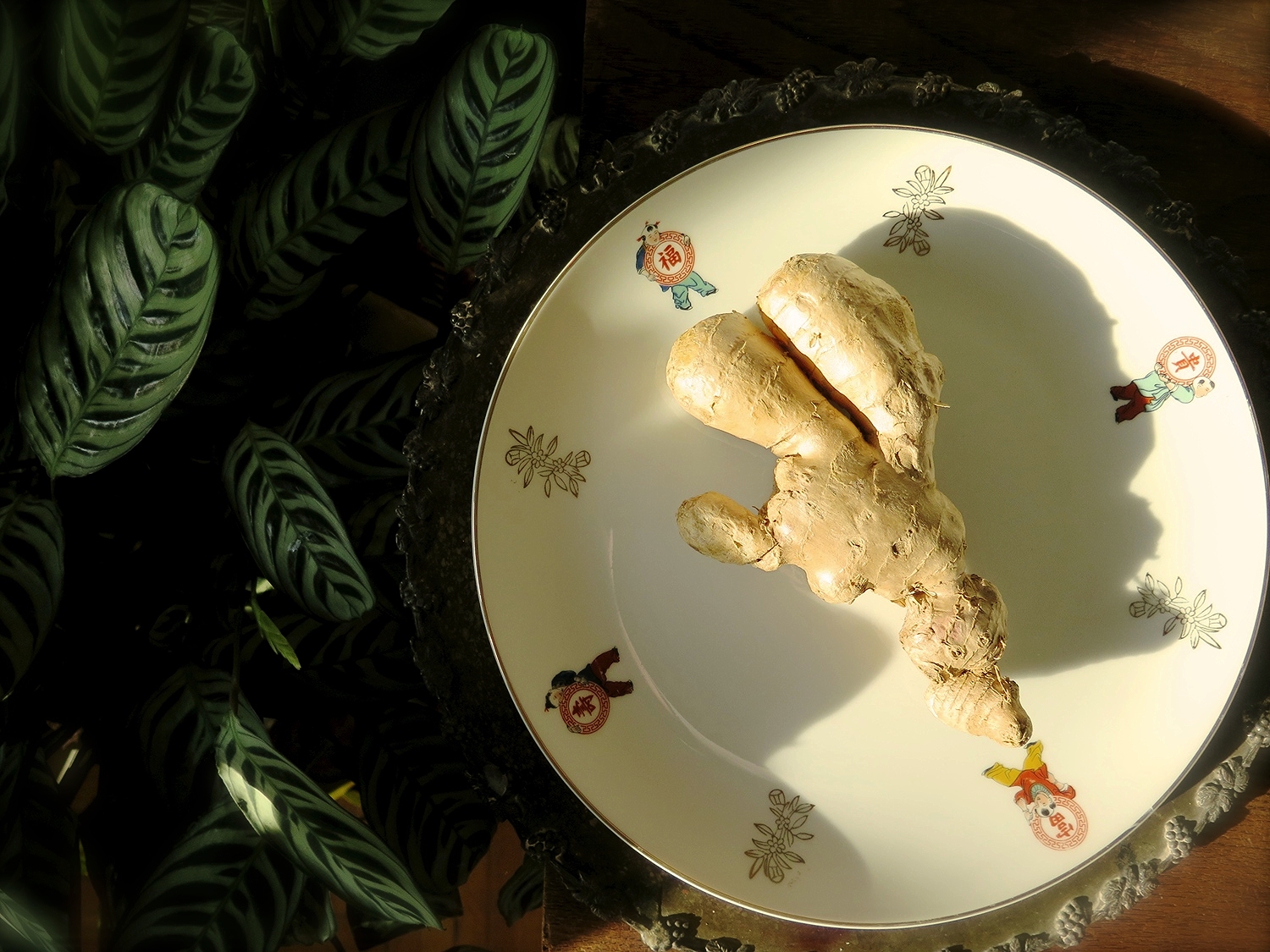Ginger ~ Vishwabhesaj ~ “the universal medicine”
Ginger is perhaps our most versatile and well-known herb. We drink ginger tea and ginger beer and eat ginger candies, pickled ginger and ginger chicken. We find ginger in curries, in fancy cocktails and in cookies. Queen Elizabeth apparently liked the herb so much that she had gingerbread men made in the likeness of her guests at court.
In Ayurveda ginger is called Vishwabhesaj, or “the universal medicine” and is said to be the most sattvic of all spices. During these cold winter days, we can use ginger to keep warm, well and vital.
Known in Latin as Zingiber officinale, ginger is part of the Zingiberaceae family, which also includes its rhizome cousins turmeric and galangal. Pungent, sweet and heating in nature, some sources say ginger originated in southern China; others say India. The truth is no one is exactly sure just how old ginger is and where it came from. This is because no one has ever found the plant growing in the wild. We do know it has been around for roughly 3000 - 4000 years and was exported to Europe from India as early as the first century AD. Today you can find it the world over. Here in New York City you can find it in almost any supermarket, sidewalk fruit stand and on the shelves of most bodegas.
While we call it ginger root, the knobby roots are actually rhizomes. Also known as creeping rootstalks, rhizomes are more like horizontal underground stems. They produce shoots and root systems of new plants and function much like a network. This system allows them to propagate asexually. Rhizomes are the worms of the plant world; cut a rhizome into pieces and each piece may just give rise to a new plant.
In my home ginger is as much a staple as bread and butter. I slice it and add it to soups and broths. I mince and sauté it with greens and vegetables. I blend it into juices, curries and daals. And of course I drink it as tea. Matthew Wood calls ginger the indispensable warming remedy and tells us that it “warms the stomach and improves digestion.” In Ayurvedic terms we would say it kindles Agni, meaning it builds our digestive fire, which is the seat of our vitality.
Ginger is also one of the best herbs for our circulatory system, another reason I love to use the plant during the winter. Our muscles tend to be tighter and more constricted this time of year. Drinking hot ginger tea increases blood flow to muscles and tendons and keeps us limber. It has also been used widely to ease joint pain and arthritis. It specifically increases peripheral circulation, making it an excellent remedy for people who suffer with chronically cold hands and feet. As a result of its effect on the circulatory system it is also a wonderful aphrodisiac.
I drink lots of ginger tea at the first sign of a cold. Ginger increases both circulation and perspiration. Both of these processes help the immune system remove the cold virus from the body. I also use ginger during my cycle to help with menstrual cramps associated with stagnant blood flow. I find it also gives me energy during this time.
My favorite way to prepare a cup of ginger tea is to grate the ginger and then steep it. (So long as it’s organic there’s no need to remove the skin). While we usually boil roots to extract their nutrients, remember ginger isn’t a true root. You only need about one teaspoon of grated ginger to make a cup of tea. A thick chunk about 1-1.5” wide will easily make 4 cups of tea. Grating and steeping the ginger creates a light and fresh flavor tea and preserves the rich volatile oils in the plant. When brewed in this way the tea becomes a beautiful pale yellow hue.
I generally use the fresh herb for tea. The dried herb is considerably hotter in its action and if over-consumed can be too heating for most people. When I am crafting herbal blends I do use the dried herb as a warming catalyst to balance out cooler brews and to gently move other plant through the body. The dried herb is also more pungent but wonderful for baking and as a food spice.
* I suggest steering clear of commercial ginger ale. It’s an imposter. While there was once a time when real ginger ale was in fashion what is on the market these days usually doesn’t involve ginger at all. Like most soft drinks it is generally a mix of high fructose corn syrup and artificial flavorings. Instead try making your own ginger ale. Brew a strong ginger tea and let it infuse for at least an hour. And honey to the infusion while it is still hot. Then add a shot of the ginger infusion to a glass of chilled sparkling water.
* Many powdered or crystallized instant ginger and honey teas on the market also contain processed sugar so read your labels well.
* As always, I suggest using organic ginger or ginger grown by a farmer whose practices you know and trust.
* While Ginger is recognized to be generally safe for regular consumption care should be taken always when using herbs while also taking pharmaceutical drugs and during pregnancy. Ginger may lower blood pressure and blood sugar; as a result people who take blood thinners, anticoagulant drugs and drugs for high blood pressure or diabetes should not use ginger without first speaking to a health care provider.
Sources: Frawley, David and Lad, The Yoga of Herbs, Twin Lakes: Lotus Press 2001
Wood, Matthew, “The Indispensable Warming Remedy”, The Earthwise Herbal. North Atlantic Books, 2008.
Khalsa, Karta Purk Singh and Tierra. The Way of Ayurvedic Herbs. Twin Lakes: Lotus Press, 2008.
Wikipeida, 2015. “Ginger”, “Gingerbread” & “Gingerale”
The University of Maryland Medical Center, “Ginger”. http://umm.edu/health/medical/altmed/herb/ginger. Februray 26, 2015.





